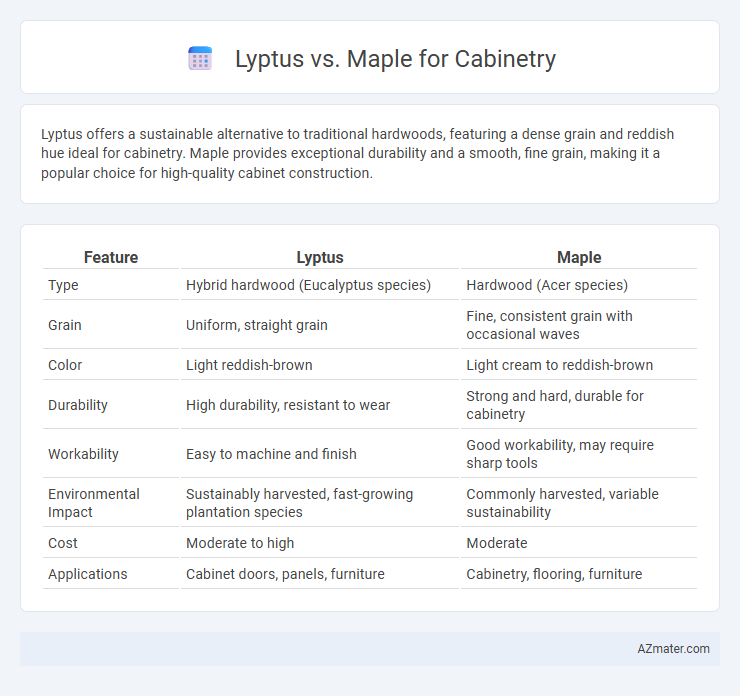Lyptus offers a sustainable alternative to traditional hardwoods, featuring a dense grain and reddish hue ideal for cabinetry. Maple provides exceptional durability and a smooth, fine grain, making it a popular choice for high-quality cabinet construction.
Table of Comparison
| Feature | Lyptus | Maple |
|---|---|---|
| Type | Hybrid hardwood (Eucalyptus species) | Hardwood (Acer species) |
| Grain | Uniform, straight grain | Fine, consistent grain with occasional waves |
| Color | Light reddish-brown | Light cream to reddish-brown |
| Durability | High durability, resistant to wear | Strong and hard, durable for cabinetry |
| Workability | Easy to machine and finish | Good workability, may require sharp tools |
| Environmental Impact | Sustainably harvested, fast-growing plantation species | Commonly harvested, variable sustainability |
| Cost | Moderate to high | Moderate |
| Applications | Cabinet doors, panels, furniture | Cabinetry, flooring, furniture |
Introduction to Lyptus and Maple for Cabinetry
Lyptus, a fast-growing hybrid eucalyptus, is prized for its dense, durable hardwood and consistent grain, making it an eco-friendly choice for cabinetry. Maple, known for its fine, uniform texture and strength, offers excellent resistance to wear and a smooth finish ideal for detailed woodworking in cabinets. Both woods provide stable structural integrity, but Lyptus's sustainability and cost-efficiency contrast with Maple's traditional appeal and widespread availability in cabinet manufacturing.
Origin and Sustainability of Lyptus vs Maple
Lyptus, a hybrid eucalyptus species, originates from sustainable plantations in Brazil, where fast growth and responsible forestry practices reduce environmental impact compared to traditional hardwood harvesting. Maple, primarily sourced from North American hardwood forests, often involves longer growth cycles and can face challenges related to deforestation and slower replenishment rates. The certified sustainable practices associated with Lyptus plantations highlight its advantage in promoting eco-friendly cabinetry materials over conventional maple sources.
Appearance and Grain Patterns
Lyptus showcases a uniform, light reddish-brown color with subtle, straight grain patterns that create a sleek and modern look for cabinetry. Maple displays a creamy white to light reddish hue with varied grain patterns ranging from straight to curly or wavy, offering a more traditional and textured appearance. The consistent grain of Lyptus appeals to minimalist designs, while Maple's diverse patterns enhance rustic and classic cabinetry styles.
Hardness and Durability Comparison
Lyptus wood exhibits a Janka hardness rating of approximately 1,410 lbf, making it harder than many traditional hardwoods, while maple scores slightly higher at about 1,450 lbf. Both species offer excellent durability for cabinetry, but maple tends to resist dents and scratches better due to its denser grain structure. Lyptus provides comparable strength with a more consistent grain, making it a sustainable yet robust option for long-lasting cabinet surfaces.
Workability and Machining Characteristics
Lyptus offers superior workability due to its consistent grain and uniform density, allowing for smooth cutting and shaping, while Maple is renowned for its hardness and durability but can be more challenging to machine because of its dense fibers. Both woods hold nails and screws well, though Lyptus tends to produce cleaner edges with less splintering. Machining characteristics favor Lyptus for intricate detailing and faster production, whereas Maple requires sharper tools and slower feed rates to prevent burnishing.
Cost and Availability Differences
Lyptus offers a cost-effective alternative to traditional hardwoods like maple, often priced lower due to faster growth cycles and sustainable plantation sources, making it an economical choice for cabinetry. Maple, widely available across North America, tends to command higher prices because of its durability, fine grain, and slower growth rate, impacting overall cabinetry costs. Availability of Lyptus can be more limited geographically compared to maple, influencing procurement considerations and project timelines for cabinet manufacturers and buyers.
Environmental Impact and Eco-Friendliness
Lyptus, a hybrid eucalyptus wood grown in sustainably managed plantations, features rapid growth rates that support carbon sequestration and reduce deforestation pressure compared to traditional hardwoods. Maple, often sourced from slower-growing hardwood forests, may involve more extensive logging and longer regrowth periods, potentially impacting forest ecosystems and biodiversity. Lyptus offers a more eco-friendly option for cabinetry by combining sustainability certifications with efficient land use and decreased chemical treatments in processing.
Finishing and Maintenance Requirements
Lyptus offers a smooth, consistent grain that readily accepts stains and finishes, resulting in a uniform appearance ideal for cabinetry. Maple features a harder surface that can sometimes cause uneven stain absorption, requiring careful sanding and sealing to achieve a flawless finish. Both woods need routine maintenance involving gentle cleaning and periodic refinishing to maintain their aesthetic appeal and durability in kitchen environments.
Performance in Kitchen and Bathroom Settings
Lyptus offers exceptional durability and resistance to moisture, making it ideal for high-humidity kitchen and bathroom environments. Maple, known for its fine grain and hardness, provides a smooth finish but may be more susceptible to water damage without proper sealing. Both woods perform well, but Lyptus's natural resistance to warping and swelling gives it a performance edge in wet conditions.
Choosing Between Lyptus and Maple for Your Cabinetry
Lyptus offers a sustainable, fast-growing hardwood option with a consistent grain pattern and natural resistance to moisture, making it ideal for eco-conscious cabinetry. Maple is renowned for its durability, fine texture, and smooth finish, providing a classic, long-lasting look favored in both traditional and contemporary designs. Choosing between Lyptus and Maple depends on balancing environmental impact, budget, and the desired aesthetic finish for kitchen or bathroom cabinetry.

Infographic: Lyptus vs Maple for Cabinetry
 azmater.com
azmater.com